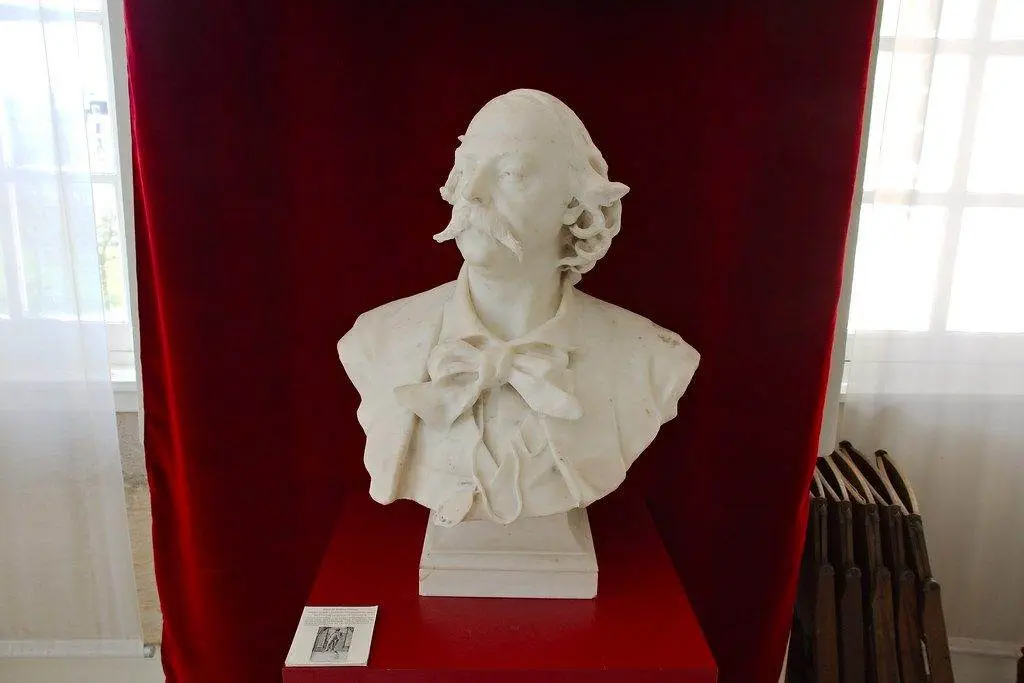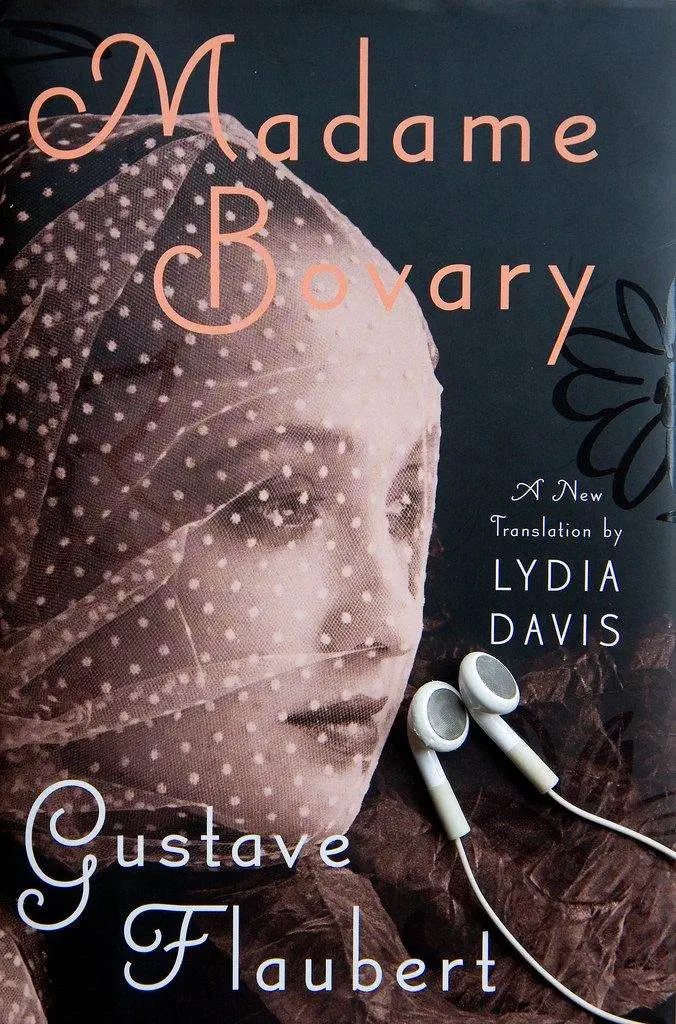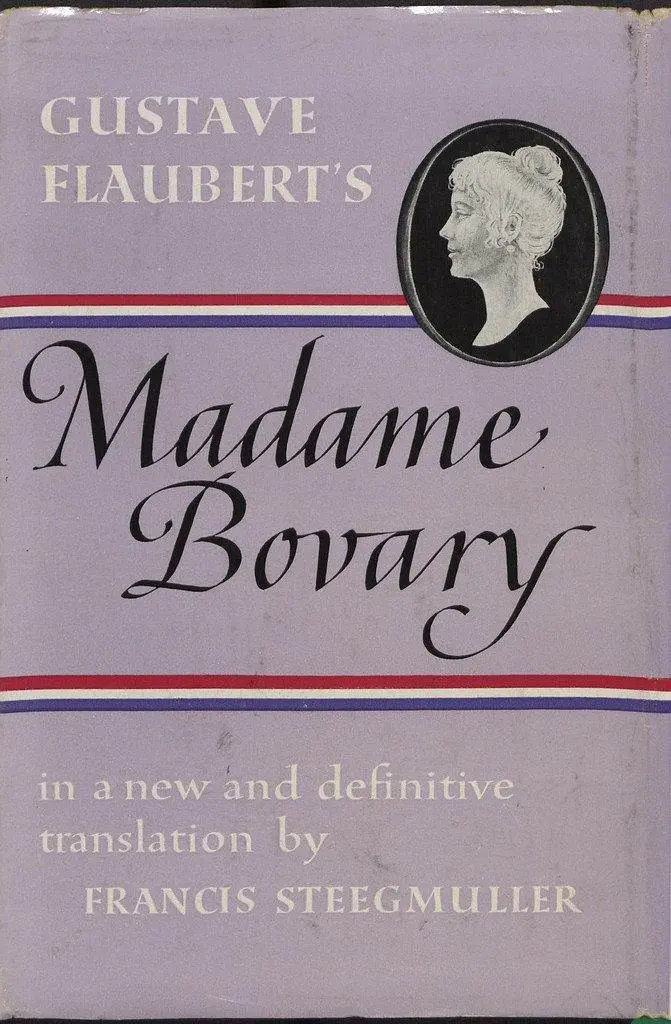Madame Bovary: Patterns of Provincial Life by Gustave Flaubert, a groundbreaking novel published in 1856, continues to captivate readers with its poignant portrayal of the complexities of human desires and societal expectations. Set in rural France, this timeless classic delves into themes such as romanticism, disillusionment, and the yearning for a more fulfilling existence. Through the protagonist Emma Bovary’s quest for passion and luxury, Flaubert weaves a narrative that exposes the harsh realities of provincial life while offering profound insights into human nature.
Table of Contents
This blog post explores the enduring relevance of Madame Bovary and provides an insightful analysis of its thematic elements and literary significance. Delving into its publication history, key characters, and critical reception over time, this exploration aims to shed light on why Madame Bovary remains an influential work in world literature.
Gustave Flaubert
Writing Style
Gustave Flaubert, known for his precise and detailed writing style, meticulously crafted each sentence. He employed free indirect speech in the narrative, allowing readers to delve into the characters’ inner thoughts seamlessly. Through this technique, he skillfully intertwined the protagonist’s emotions with the narration itself. Furthermore, Flaubert’s emphasis on descriptive language and sensory details immersed readers in the world of his characters.

Flaubert’s use of free indirect speech is evident in “Madame Bovary,” where he seamlessly transitions between a third-person perspective and Emma Bovary’s internal monologue. This literary device creates a sense of intimacy between the reader and the character, offering insight into Emma’s motivations and desires without explicitly stating them.
The author’s attention to descriptive language is exemplified by his portrayal of Madame Bovary’s surroundings. From her opulent yet suffocating lifestyle to her yearning for freedom, Flaubert paints a vivid picture through meticulous descriptions that evoke strong sensory experiences for readers.
Literary Significance
Flaubert’s work has had a profound impact on the development of modern novels due to its innovative narrative techniques and psychological depth. “Madame Bovary” faced controversy and censorship upon its initial publication due to its unapologetic depiction of adultery and societal hypocrisy. However, it ultimately contributed to shaping future literary movements by challenging conventions.
The novel’s influence extends beyond its initial reception; subsequent generations of writers have drawn inspiration from Flaubert’s groundbreaking approach to storytelling. His ability to dissect human nature with unwavering honesty paved the way for authors who sought to explore complex characters within intricate narratives.
Plot Synopsis
Key Characters
Madame Bovary, written by Gustave Flaubert, features Emma Bovary as the central character. She is depicted as a complex and tragic figure whose dissatisfaction with her provincial life leads to her downfall. Charles Bovary, Emma’s husband, is portrayed as earnest but unremarkable in nature, providing a stark contrast to his wife. The novel also delves into the contrasting personalities of Homais and Lheureux, who play pivotal roles in influencing Emma’s decisions.
The portrayal of Emma Bovary in “Madame Bovary” showcases her deep dissatisfaction with provincial life and her relentless pursuit of romantic fulfillment. Charles Bovary’s earnest but unremarkable nature serves as a foil to his wife’s restless spirit, highlighting the stark differences between them. Homais and Lheureux represent conflicting influences on Emma—Homais embodies ambition and intellectualism while Lheureux symbolizes greed and manipulation.
Major Events
The narrative unfolds through various major events that shape the characters’ destinies in “Madame Bovary.” Emma’s romantic affairs and subsequent disillusionment form a significant part of the storyline, reflecting her yearning for excitement beyond the confines of provincial life. Charles’ medical struggles and financial difficulties add depth to the plot, creating an atmosphere of hardship that contributes to Emma’s sense of entrapment.
The novel reaches its tragic climax with events leading to Emma’s demise serving as a poignant conclusion to her tumultuous journey. These key events not only drive the narrative forward but also offer profound insights into human desires, societal constraints, and the consequences of unrestrained passion.
Provincial Life Depiction
Social Norms
Madame Bovary by Gustave Flaubert provides a vivid exploration of provincial life in 19th-century France, offering a scathing critique of bourgeois values and hypocrisy. The novel delves into the societal expectations prevalent during that era, shedding light on the rigid gender roles and marriage norms that governed individuals’ lives. For instance, Emma’s dissatisfaction with her provincial existence reflects the constraints placed upon women at the time.
Flaubert skillfully portrays how societal expectations stifle individuality and perpetuate disillusionment among characters like Emma Bovary. Through her character, he critiques the oppressive nature of gender roles and highlights their detrimental impact on personal fulfillment within provincial communities. By emphasizing the stark contrast between social appearances and inner turmoil, Flaubert exposes the facade of respectability maintained by many characters in conforming to these norms.
Economic Factors
In addition to dissecting social norms, Madame Bovary also offers a compelling depiction of financial pressures faced by its characters – particularly the Bovarys. The influence of economic status is intricately woven into every aspect of their lives, dictating their choices and opportunities within their provincial setting. This portrayal effectively conveys how economic disparities permeate through every layer of society during this period.
The economic struggles faced by Charles and Emma Bovary serve as a reflection of class disparities inherent in provincial life. Their aspirations for upward mobility are thwarted by financial limitations imposed upon them due to their station in life. By illustrating these challenges through vivid descriptions of everyday life in a rural village setting, Flaubert captures the pervasive impact that economic factors had on individuals living within such communities.
Themes and Motifs
Romanticism
Madame Bovary, written by Gustave Flaubert, delves into Emma’s idealized notions of love and passion. Throughout the novel, Emma constantly seeks a romanticized version of love and life, often contrasting with the harsh realities she faces. For example, her pursuit of romance leads her to engage in extramarital affairs as an escape from her mundane provincial life. This stark contrast between Emma’s romantic fantasies and the actualities of her existence serves as a central theme in the novel.

Moreover, Flaubert employs romantic elements in the narrative structure itself to emphasize Emma’s yearning for idealistic love. The lyrical prose and vivid descriptions used when detailing Emma’s emotional states create an atmosphere that aligns with romantic literary traditions. By intertwining these elements throughout the story, Flaubert not only showcases Emma’s longing for passionate romance but also presents a commentary on societal expectations regarding love during that era.
Reality vs. Illusion
The theme of escapism versus confronting reality is prevalent in Madame Bovary as characters grapple with living in delusions or falsehoods instead of facing their truths head-on. For instance, Charles Bovary remains oblivious to his wife’s infidelities due to his own illusion about their marriage being idyllic. This juxtaposition between reality and illusion underscores how individuals within this provincial setting seek refuge from their unfulfilling lives through various forms of deceit.
Furthermore, symbolic representations of illusion are scattered throughout the story to underscore this thematic element effectively. From Madame Bovary’s excessive spending habits symbolizing her desire for an extravagant lifestyle beyond her means to Rodolphe’s empty promises representing illusory hope for change—these instances serve as poignant reminders that illusions can have detrimental consequences when confronted by harsh realities.
Read This Too: To Kill a Mocking Bird
Characters Analysis
Emma Bovary – Analysis of Emma’s dissatisfaction with provincial life – Exploration of her pursuit of passion and fulfillment – Impact of societal constraints on Emma’s choices
Emma Bovary, the protagonist in “Madame Bovary,” is a character deeply dissatisfied with provincial life. She yearns for excitement and passion, feeling stifled by the mundane routines and expectations placed upon her. Her dissatisfaction stems from a desire for something more, something beyond the ordinary existence she leads. This longing drives her to seek fulfillment through romantic affairs and indulgence in luxurious fantasies, ultimately leading to her downfall.
Emma’s relentless pursuit of passion and fulfillment is evident throughout the novel as she engages in extramarital affairs while searching for an idealized love that will rescue her from the monotony of everyday life. Her infidelity reflects not only her discontent but also her unyielding quest for emotional satisfaction outside the boundaries set by society.
The impact of societal constraints on Emma’s choices becomes clear as she navigates through various relationships and experiences. The societal norms governing women during this period restrict Emma’s ability to pursue personal desires freely, forcing her into roles that do not align with her inner aspirations. These limitations contribute significantly to Emma’s feelings of entrapment within provincial life.
Charles Bovary – Charles’ devotion to Emma despite her infidelity – Examination of his limited ambitions and lack of assertiveness – Role as a representation of mediocrity in provincial society
Charles Bovary’s unwavering devotion to Emma stands out amidst his wife’s indiscretions. Despite being aware of Emma’s infidelities, he remains committed to their marriage, reflecting his deep affection for his wife even when faced with betrayal.
His character embodies limited ambitions and lackluster assertiveness throughout the narrative. Charles lacks ambition or drive beyond what is expected or accepted within provincial society; he conforms comfortably within its confines without seeking personal growth or advancement.
As a representation of mediocrity in provincial society, Charles epitomizes individuals who conform unquestioningly to societal norms without challenging them or striving for individual agency or self-improvement. His passivity serves as a stark contrast to Emma’s restless pursuit for something more profound than what their environment offers.
Style and Writing Techniques
Realism Approach
Gustave Flaubert’s writing in “Madame Bovary” reflects his commitment to portraying everyday life authentically. He meticulously details mundane routines and domestic settings, offering a realistic portrayal of provincial life. Unlike the romanticized portrayals prevalent in literature at the time, Flaubert’s approach emphasizes the ordinary aspects of existence.
Flaubert critiques the idealized representations found in many literary works by providing an unembellished depiction of daily life. For instance, he portrays Emma Bovary’s dissatisfaction with her marriage and societal constraints as part of everyday reality rather than a dramatic or exaggerated circumstance. This realistic approach allows readers to connect with the characters on a deeper level, as they can relate to their experiences and emotions.
Symbolism Use
In “Madame Bovary,” Gustave Flaubert employs symbolic significance attached to various objects and settings throughout the narrative. Objects such as the wedding bouquet or the blind beggar carry symbolic weight, representing themes like desire, disillusionment, or societal disparity. These symbols enrich the story by adding layers of meaning beyond their literal representation.
Furthermore, Flaubert utilizes symbolic settings like Yonville-l’Abbaye to represent broader ideas about provincial life and societal norms. The town becomes a symbol for mediocrity and conformity within small communities during that era. Symbolism related to nature is prevalent throughout the novel; flowers are often used metaphorically to convey emotions or foreshadow events in Emma’s life.
Adaptations and Translations
English Translations
English translations of Madame Bovary: Patterns of Provincial Life by Gustave Flaubert have significantly influenced readers’ interpretation. The nuances of Flaubert’s prose present challenges in capturing the essence in English. For instance, different translated versions can alter the tone, mood, and even character portrayal.
Comparing various translated versions can illustrate how word choices impact readers’ understanding. For example, one translation may emphasize romantic elements while another focuses on societal critique. Such variations showcase the influence translators hold over shaping readers’ perception.
The challenges in capturing Flaubert’s nuanced prose in English are evident when comparing multiple translations side by side. Readers can observe how certain expressions or descriptions differ across versions, leading to varied emotional responses and interpretations.
Film Adaptations
Film adaptations offer diverse cinematic interpretations of Madame Bovary, showcasing a range of visual retellings that impact popular culture. Each adaptation brings forth unique perspectives on Flaubert’s narrative through directorial choices, casting decisions, and visual storytelling techniques.
These adaptations not only bring the story to life but also contribute to its enduring presence within popular culture. They enable audiences to experience Flaubert’s work through a different artistic medium, potentially reaching individuals who may not engage with literature extensively.
However, film adaptations also come with limitations in capturing the depth and complexity of Flaubert’s narrative on screen. Certain aspects of the novel may be challenging to convey visually or could lose their subtlety when translated into cinematic language.
Literary Reception
Initial Criticism
When Madame Bovary was first published, it sparked public outrage due to its perceived immorality. Legal action was even taken against the novel for its content. Many literary figures at the time also responded critically to Gustave Flaubert’s work.
The initial public reaction to “Madame Bovary” reveals the controversial nature of Flaubert’s portrayal of provincial life and Emma Bovary’s pursuit of passion and fulfillment. The legal action taken against the novel underscores the extent of societal discomfort with its themes, highlighting how it challenged prevailing moral standards. Critical responses from literary figures reflect the polarizing impact that “Madame Bovary” had on contemporary readers and intellectuals.
Modern Perspective
In a modern context, there has been a significant reevaluation of Emma Bovary as a feminist figure. Contemporary scholars have recognized her as an early representation of female agency and rebellion against societal constraints. Furthermore, “Madame Bovary” remains relevant due to its exploration of themes such as consumerism and materialism.
The ongoing scholarly interest in Flaubert’s techniques and themes demonstrates the enduring significance of “Madame Bovary.” Its exploration of human desires, disillusionment, and societal expectations continues to captivate readers across generations. Moreover, adaptations and translations further contribute to sustaining this relevance by making Flaubert’s masterpiece accessible to diverse audiences.
Related Works Comparison
Thematic Similarities
Madame Bovary: Patterns of Provincial Life by Gustave Flaubert shares thematic similarities with other works exploring discontentment in marriage. For instance, when comparing it to “Anna Karenina” by Leo Tolstoy, both novels delve into the dissatisfaction and disillusionment experienced within marital relationships. In a similar vein, Madame Bovary resonates with readers due to its portrayal of societal norms and expectations. This is reminiscent of other literary works critiquing societal norms, such as “The Awakening” by Kate Chopin.
Moreover, Madame Bovary exhibits common motifs shared with other realist literature. The novel’s realistic portrayal of everyday life reflects the essence of realism found in works like “Middlemarch” by George Eliot. Both novels capture the intricacies and complexities of human behavior within their respective societies.
Influence on Literature
Flaubert’s masterpiece has had a profound impact on subsequent generations of realist writers. Its exploration of human psychology and social dynamics has influenced countless authors who followed in Flaubert’s footsteps. Notably, Madame Bovary holds a legacy as a seminal work in French literature due to its innovative narrative techniques and compelling storytelling.
Furthermore, the influence of Madame Bovary extends beyond its initial publication period and continues to resonate with modern storytelling techniques. The novel’s nuanced character development and intricate plot structures have served as inspiration for contemporary writers seeking to craft compelling narratives that captivate audiences.
Final Remarks
In conclusion, Gustave Flaubert’s Madame Bovary masterfully captures the complexities of provincial life, weaving together themes of love, desire, and societal expectations. Through a rich tapestry of characters and meticulous attention to detail, Flaubert provides a profound exploration of human nature and the consequences of pursuing unrealistic ideals. The novel’s enduring literary impact is evident in its numerous adaptations and translations, as well as in its continued resonance with readers and scholars alike.
For those seeking a deeper understanding of 19th-century literature or an insightful analysis of human behavior, Madame Bovary remains an essential read. Its timeless relevance prompts reflection on the universal pursuit of happiness and the pitfalls of romanticized aspirations. Whether for academic study or personal enrichment, delving into Flaubert’s masterpiece offers a thought-provoking journey into the intricacies of human experience.
Frequently Asked Questions
What are the major themes in “Madame Bovary” by Gustave Flaubert?
The major themes in “Madame Bovary” include the dissatisfaction with provincial life, the consequences of romanticism and escapism, societal expectations, and the struggle for personal fulfillment.
How does Gustave Flaubert’s writing style contribute to “Madame Bovary”?
Gustave Flaubert’s meticulous attention to detail, use of free indirect speech, and precise language contribute to creating a vivid portrayal of characters’ emotions and inner thoughts. His writing style enhances the exploration of complex human experiences.
What are some notable adaptations or translations of “Madame Bovary”?
Notable adaptations include film versions directed by Claude Chabrol and Sophie Barthes. In terms of translations, Lydia Davis’ translation is highly regarded for capturing Flaubert’s original prose with precision.
How was “Madame Bovary” received by literary critics at its time of publication?
Initially controversial due to its perceived immorality, “Madame Bovary” later gained acclaim for its realistic portrayal of human psychology. Critics praised Flaubert’s masterful storytelling and his ability to capture the nuances of provincial life.
How does Gustave Flaubert depict provincial life in “Madame Bovary”?
Flaubert depicts provincial life as mundane yet suffocating, filled with social constraints and limited opportunities for personal growth. Through Emma’s disillusionment with her surroundings, he exposes the stifling nature of small-town existence.


